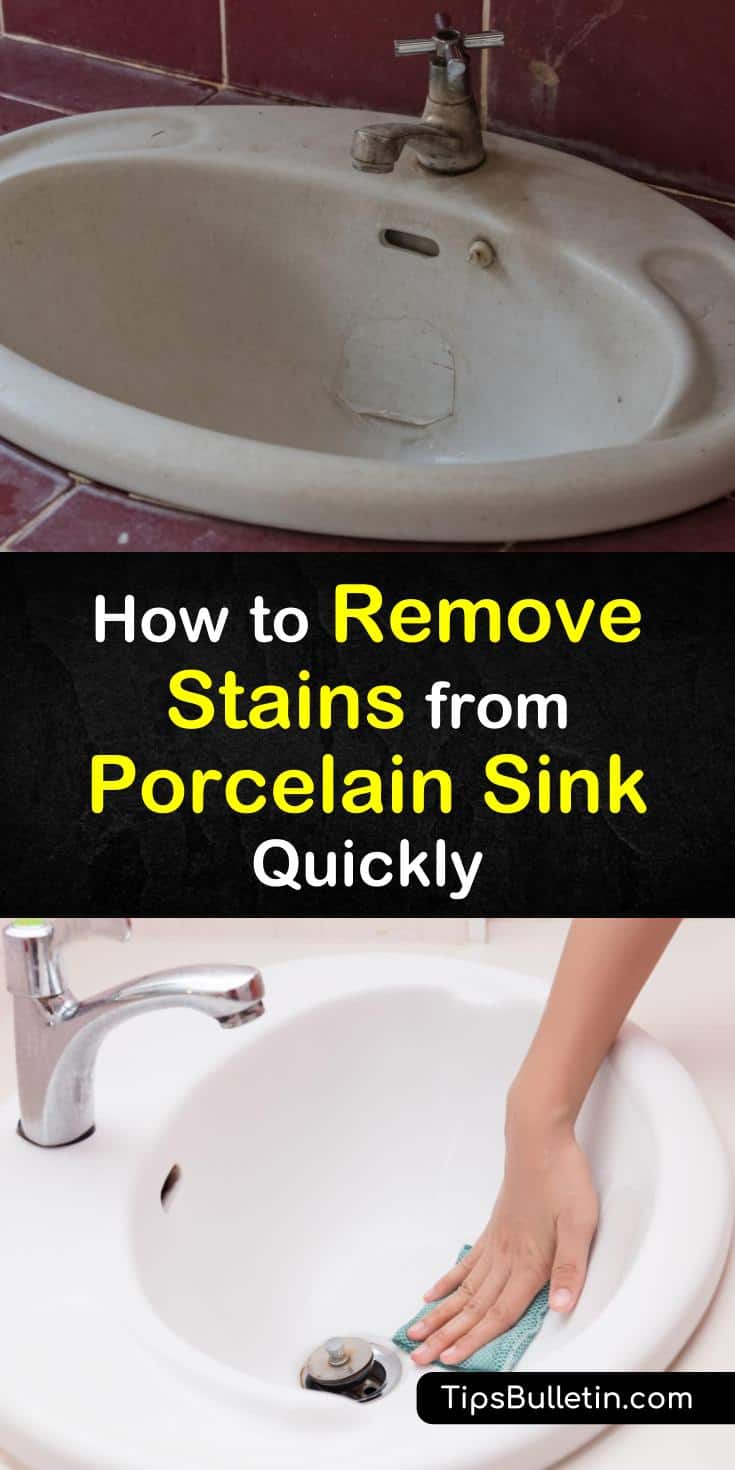Porcelain sinks that are cleaned and maintained correctly are glossy with a smooth and attractive appearance. Not knowing how to clean porcelain correctly can leave you with unsightly bathroom or kitchen sink, stained with rust, mold, and hard water stains. Learn how to remove stains from porcelain sink using simple ingredients to keep them clean and shiny.
Porcelain sinks are available in a wide variety of colors and can be either solid porcelain or a porcelain enamel coating over a material such as cast-iron. They are durable and relatively low maintenance but do require a certain measure of care when it comes to cleaning due to the unfortunate fact that porcelain tends to stain easier than other materials.

Removing Stains from a Porcelain Sink
Knowing how to remove hair dye stains from sink, as well as hard water stains, rust, and mold, can make all the difference when it comes to a white porcelain sink. The longer these types of stains remain on your white porcelain, the harder they are to remove. Therefore, it’s essential to clean porcelain sinks as soon as possible to prevent staining.
Using abrasives to clean a porcelain kitchen sink or bathroom sink is a big no-no. Doing this can leave scratches on the surface of the porcelain and lead to discoloration. You should also avoid using harsh chemicals for cleaning porcelain enamel. We’ll show you how to get stains out of porcelain sink safely and effectively.
Getting Stains Out of Porcelain Sink
Rust stains in a porcelain sink are a tell-tale sign that your sink has a slow water leak in the faucet. This type of staining is also an indicator that your water contains a lot of iron. The following shows you how to get stains out of porcelain sink and remove rust from porcelain in a few simple steps.

To make this simple but quite effective DIY porcelain sink cleaner, combine enough Borax and lemon juice in a small bowl to form a pasty substance. Dip the sponge into the paste and apply it to the rusty areas of the sink with just a little bit of pressure.
Let it dry on the stained area and let the combination of lemon juice and Borax do their job. Rinse the sink with clean water and dry with paper towels. Repeat if necessary for stubborn stains.
Remove Hair Dye Stains from Sink
It’s easy to miss small splatters and drips from hair dye while dying your hair. Initially, those little spots seem harmless and are hard to notice, that is until they begin to change from a light cream color into a horrible purple stain!
We show you how to remove hair dye stains from sink so that you can breathe a sigh of relief. We have included several individual ingredients that you can try.
Any of these ingredients can be used to remove hair dye from the porcelain sink. To remove the stains with nail polish remover, rubbing alcohol, or hydrogen peroxide, apply one of the solutions onto a couple of cotton balls and rub the stains away. If you’re opting to use the Magic Eraser, get the eraser wet and rub the stained area gently.
Remove Hard Water Stains from a Porcelain Sink
Hard water stains are the result of calcium and mineral deposits that are left behind from your water. Over time, they can leave a crusty looking residue on the bottom of your porcelain sink.
Here is a ready-made cleaning solution that only requires a little bit of elbow grease to deep clean porcelain and help it look like new again. You can also use this method for cleaning stainless steel and other areas around the kitchen.
Begin by testing the product on an inconspicuous area first to ensure that it is safe for your particular sink. Get the sink wet with warm water and then sprinkle a small amount of the cleanser onto the stained areas.
Use a sponge to blend the powder into the water so that paste forms and allow it to sit for a few minutes. Use the sponge to gently scrub away the stains. Finish up by rinsing the sink with clean water.
Removing Mold and Mildew Stains from a Porcelain Sink
Mold and mildew growth in the sink is not only gross and stinky but can be hazardous to your health. This cleaning method uses baking soda to eliminate mold and mildew odors, and vinegar to break down the fungal growth. Baking soda can also be used to remove scratches from porcelain sink by buffing them away with a soft, damp cloth.
Make a paste substance by mixing a small amount of baking soda with water. Apply the paste to the moldy areas of the sink and let it sit for about half an hour. In the meantime, pour the vinegar and water into a spray bottle and label for future use.
Spray the vinegar water onto the baking soda paste and allow the two ingredients to bubble while they work on the stain. Use a sponge to wipe away the moldy residue and rinse the sink with clean water.
Believe us when we say that no one wants to clean a bathroom sink, but it is something we all must do. The good thing is, you can clean your porcelain sink using simple ingredients to eliminate rust, mold, hard water stains, and the build up of scum in just a few simple steps.
Use a little dish soap and hot water for easy cleanups or bring out the baking soda to buff away scratches and white vinegar to remove tough stains.

We hope that you enjoyed learning how to remove stains from porcelain sink, and we’d love it if you shared our porcelain sink cleaning tips and recipes with your family and friends on Pinterest and Facebook.